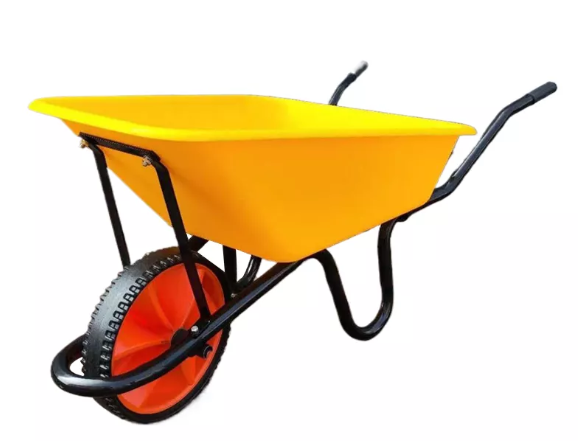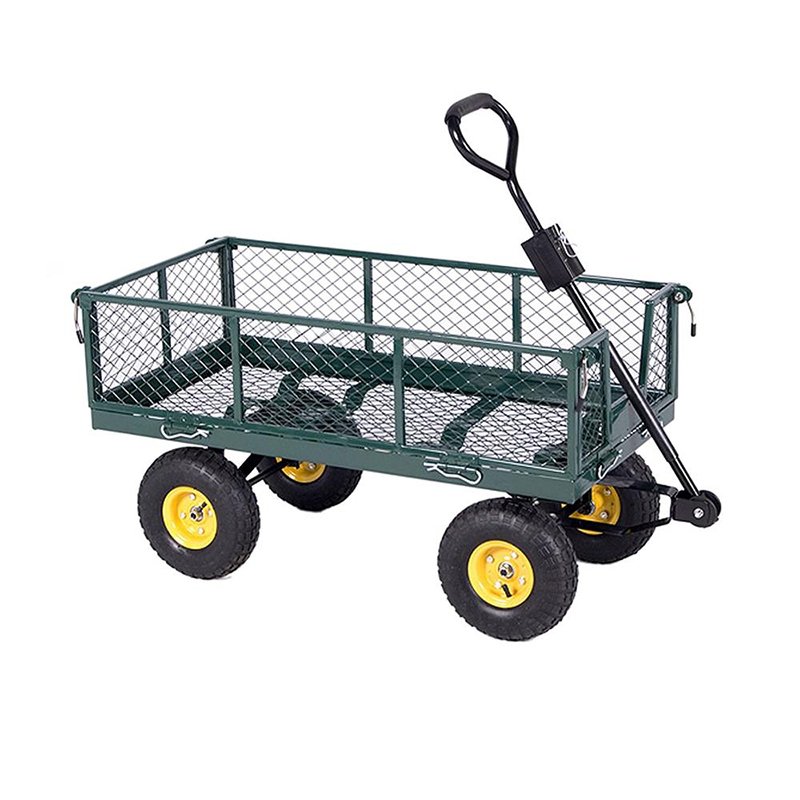- All
- Product Name
- Product Keyword
- Product Model
- Product Summary
- Product Description
- Multi Field Search
Please Choose Your Language
Views: 0 Author: Site Editor Publish Time: 2025-06-06 Origin: Site









When it comes to gardening, landscaping, or construction, choosing the right tool can make a significant difference. Two common tools that come to mind are yard carts and wheelbarrows. Both are designed to help you move heavy loads, but each has unique features that make it suitable for different tasks.This article aims to compare yard carts and wheelbarrows, exploring their advantages and disadvantages. By the end, you should have a clear understanding of which tool is better suited for your specific needs, whether you’re working on a large construction project or just tidying up your garden.
Definition and Features: A yard cart is a type of wheeled container designed for hauling heavy loads. Typically, they have large, air-filled (pneumatic) wheels that make it easier to transport materials across lawns, gravel, or other uneven terrain. Unlike wheelbarrows, yard carts usually have straight sides and a pulling design, allowing users to move larger volumes with less effort.
Common Uses: Yard carts are ideal for moving large amounts of mulch, soil, firewood, or even plants. Their pulling design allows for easy transport over flat or gently sloped surfaces, making them perfect for tasks like lawn maintenance, garden work, and hauling heavy materials.
Definition and Features: A wheelbarrow is a smaller, more compact wheeled tool used for transporting lighter loads. Most wheelbarrows have a sloped tray, one or two wheels in the front, and handles at the rear for pushing. The design of a wheelbarrow makes it highly maneuverable and easy to navigate in tight spaces or on uneven surfaces.
Common Uses: Wheelbarrows are commonly used for tasks like hauling soil, compost, rocks, or small building materials. Their ability to navigate rough terrain and tight corners makes them suitable for gardening, construction, and landscaping projects.
Design and Maneuverability
Yard Carts: Designed for pulling, they generally have larger wheels and a flatbed design. This makes them more stable and able to carry heavier loads, but they’re less maneuverable than wheelbarrows. Yard carts work best on smooth, even surfaces, although some are designed to handle light rough terrain.
Wheelbarrows: Feature a sloped tray and one or two wheels in the front. They are designed to be pushed, which makes them more maneuverable in tight spaces and uneven ground. The sloped design helps distribute weight, making them easier to handle when lifting and maneuvering.
Weight Distribution and Load Capacity
Yard Carts: Typically have a higher volume and are able to carry larger, heavier loads. The weight is distributed more evenly over the larger wheels, allowing for easier pulling.
Wheelbarrows: Have a smaller load capacity, making them better suited for lighter loads or more precise tasks. The sloped tray helps distribute the weight, but wheelbarrows are best for handling smaller quantities.

Handling and Ease of Use
Yard Carts: The pulling design reduces the physical strain on the user, making them easier to use over long distances. However, they are less ideal for navigating tight spots.
Wheelbarrows: Require more physical effort to push, but their maneuverability makes them better for short trips and tasks that need precision.
| Feature | Yard Carts | Wheelbarrows |
|---|---|---|
| Design | Pulling, stable, large wheels | Pushing, sloped tray, maneuverable |
| Load Capacity | Higher volume, heavy-duty loads | Smaller capacity, better for precision |
| Maneuverability | Less maneuverable, works on smooth surfaces | More maneuverable, handles uneven ground |
| Handling | Easy to pull, less effort | Requires more effort to push |
| Best Use | Hauling large, heavy loads | Ideal for precise tasks, smaller jobs |
Ideal for Larger Loads
Yard carts are perfect for large, heavy loads that would be difficult to carry in a wheelbarrow. Whether you’re hauling soil, mulch, or firewood, yard carts can handle more volume with less effort.
Easy to Pull
Unlike wheelbarrows, which require pushing, yard carts can be pulled, which significantly reduces the effort needed to transport heavy loads. This is especially helpful for individuals who may struggle with pushing heavy items.
More Stability
With larger wheels and a more stable design, yard carts are less likely to tip over, making them a safer option for carrying bulky or unevenly shaped materials. This stability also makes them ideal for use on softer ground, such as lawns.
| Task | Why Yard Cart Is Ideal |
|---|---|
| Hauling soil and mulch | Large volume capacity, easy to pull |
| Transporting heavy materials | Better weight distribution, stable |
| Moving items on flat terrain | Large wheels provide better stability |
Maneuverability in Tight Spaces
Wheelbarrows excel in tight spaces and are more agile than yard carts. If you’re working in a garden with narrow paths or navigating around obstacles, a wheelbarrow is the best choice.
Suitable for Uneven Terrain
Wheelbarrows are designed to handle rough, uneven terrain. Whether you're working on a construction site or a garden with hills, the single or dual-wheel design allows for better stability and control.
Easier to Store
Wheelbarrows are typically more compact than yard carts, making them easier to store in small spaces like sheds or garages. They can often be leaned against a wall or stacked, saving valuable storage space.
| Task | Why Wheelbarrow Is Ideal |
|---|---|
| Moving soil and mulch | Precision handling, easy for small loads |
| Working on uneven terrain | Maneuverable, better for rough ground |
| General garden maintenance | Compact, easy to store and maneuver |
Yard carts are ideal for large, bulkier jobs that involve moving large amounts of material. Their higher load capacity makes them more suitable for tasks like hauling mulch, soil, or compost in large quantities. However, wheelbarrows are better for smaller, more precise movements where you need to control the amount being transported.
Yard carts are great for heavy-duty tasks that require transporting large amounts of materials over smooth ground. For landscaping and construction, where large volumes of materials need to be moved frequently, a yard cart offers a practical solution. On the other hand, wheelbarrows are perfect for detailed work like carrying smaller loads of stones, cement, or soil in areas with uneven surfaces.
For general gardening tasks like trimming, weeding, or planting, wheelbarrows tend to be more versatile. They are easier to maneuver around plants and structures and are well-suited for smaller, more precise loads. Yard carts, while ideal for large-scale hauling, may be overkill for smaller, routine tasks.

Consider Load Size and Frequency
If you regularly move heavy or large loads, a yard cart is likely the better choice. For lighter, less frequent tasks, a wheelbarrow might be more suitable.
Think About the Terrain You’ll Be Working On
Yard carts are better suited for smooth, even surfaces, while wheelbarrows excel on uneven or rough terrain. Think about where you'll be using the tool most.
Personal Physical Considerations
If you have limited strength or experience difficulty pushing heavy loads, a yard cart may be a better option since it is pulled rather than pushed.
Storage Space
Consider the space you have available for storage. Yard carts require more space due to their larger size, while wheelbarrows are more compact and easier to store.
Both yard carts and wheelbarrows have their unique advantages, and the best choice depends on your specific needs. If you're looking to move large volumes and heavy materials over smooth surfaces, a yard cart is likely the better option. If you need precision, maneuverability, and the ability to work on uneven ground, a wheelbarrow is your go-to tool.
A: Generally, yard carts tend to be more expensive than wheelbarrows due to their larger size, higher load capacity, and more durable construction. Yard carts typically have larger wheels and more complex frames, which increases the cost. However, prices vary depending on the brand, material, and features of the cart or wheelbarrow. It's always a good idea to compare products to find the best value for your needs.
A: While wheelbarrows can carry substantial loads, they are better suited for smaller, more precise hauling. If you try to overload a wheelbarrow, it can become difficult to maneuver and may lead to tipping. For very large or heavy loads, a yard cart is usually the better option because it has a larger capacity and is easier to pull over long distances.
A: Yard carts generally require more maintenance than wheelbarrows due to their larger size and more complex components. The pneumatic tires on yard carts, for example, may need to be inflated regularly, and the frame may need to be checked for any signs of wear and tear. Wheelbarrows, with simpler designs and solid wheels, typically require less maintenance but should still be checked periodically for any damage or rust.
A: While yard carts can handle some rough terrain, they perform best on flat, even surfaces. Many yard carts have large pneumatic tires that are designed for soft ground, like lawns, but they may struggle on more rugged or uneven surfaces. For rough terrain or steep inclines, a wheelbarrow may be more suitable due to its maneuverability and the ability to better navigate obstacles.
A: For small garden tasks like weeding, planting, or transporting smaller amounts of soil or plants, a wheelbarrow is typically the better choice. Its compact size and maneuverability make it ideal for precise work in tight spaces. Yard carts, with their larger capacity, are more suited for bigger projects or transporting larger loads.